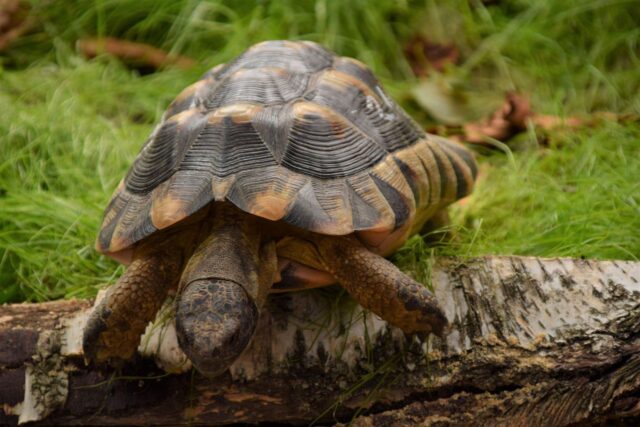The Turtle Museum, located in the village of Inea near Lara Bay beach in the Paphos district, is a unique site dedicated to the study and conservation of Cyprus’s sea turtles. Opened in 2023, it became the island’s first museum entirely dedicated to these rare marine inhabitants. The institution combines the functions of an educational center, a research site, and a cultural landmark, where modern technology meets Cyprus’s natural heritage.
Contents
Location and general description
The museum is located in the mountain village of Oineia, approximately 15 kilometers from Paphos and just a few minutes’ drive from the famous Lara Bay beach—one of the main sea turtle nesting sites in Cyprus. The museum building blends harmoniously with the architecture of a traditional Cypriot village, preserving stone elements while blending them with a contemporary interior.
The total exhibition area is approximately 180 square meters, but the space is organized in such a way that visitors take a complete journey—from the ancient history of turtles to modern environmental programs for their conservation.
History of creation
The idea for the museum came from Cypriot environmentalists and volunteers involved in protecting sea turtles on the Akamas coast. The museum is a logical continuation of the conservation program for the Caretta caretta (loggerhead turtle) and Chelonia mydas (green turtle) species found off the island’s coast.
The creation of the museum was supported by the Inei Municipality and the Department of Nature Conservation. Its main goal is to raise awareness among the public and tourists about the role of sea turtles in the ecosystem, their vulnerability, and the need to protect their nesting sites.

The exhibition and halls of the museum
The museum’s exhibition is divided into several thematic zones.
Historical and Scientific Hall
The first hall introduces visitors to the evolution of turtles, which have existed on the planet for over 200 million years. It features reconstructions of ancient marine reptiles, interactive migration maps, and detailed displays explaining the species of turtles living in the Mediterranean Sea.
Ecological hall
The second part of the museum is dedicated to the modern life of sea turtles. The exhibit features nest models, models of beaches with egg laying sites, photographs of underwater scenes, and videos of the hatchling process. Visitors will learn how artificial lighting, fishing nets, and pollution affect turtle populations.

Educational and children’s center
The exhibition features multimedia panels, touch screens, educational games, and a dedicated area for school groups. Special attention has been paid to accessibility—part of the exhibit is adapted for people with visual and hearing impairments.
The museum is equipped with interactive displays where you can listen to real sea sounds, examine turtle shells, and compare the sizes of hatchlings and adults.
The importance of the museum and its environmental mission
The Inei Turtle Museum plays a vital role in fostering environmental culture and ecotourism in Cyprus. It is closely linked to the Akamas Nature Reserve and Lara Bay Beach, where turtle nesting observations are held annually.
Museum scientists and volunteers participate in programs to rescue clutches, transfer eggs to safe zones, count hatchlings, and monitor population sizes.
Visitors will learn why turtles are considered “indicators of marine health” and how even the slightest changes in the ecosystem affect their behavior. The museum emphasizes the need for careful coastal management, proper plastic disposal, and the control of tourism on nesting beaches.
What to see and do
In addition to the permanent exhibition, the museum hosts temporary exhibitions, lectures, workshops, and meetings with biologists. Here you can:
- attend interactive presentations about the life of turtles;
- see real samples of shells and eggs;
- watch videos from underwater cameras in the Akamas bays;
- take a short route to the observation decks, which offer views of the sea and the nature reserve.
Next to the museum, there’s a souvenir stand selling handicrafts, eco-friendly accessories, and books about Cypriot nature. A portion of the proceeds goes to support a turtle conservation program.
Practical information for visitors
The museum is open all year round, except for winter public holidays.
Estimated opening hours:
- from April to October – from 10:00 to 17:30 (on Saturday until 14:30);
- from November to March – shortened hours until 16:00.
Admission is free, but donations for the museum’s development are welcome.
Parking is located next to the main entrance, and the building is accessible by ramps.
You can get there by car from Paphos (about 25 minutes along the highway through Peyia). The nearest bus stop is in Coral Bay, from where you can take a taxi.
Tips for tourists
It’s best to plan a visit to the museum along with a trip to Lara Bay Beach, where you can see real turtle nesting sites and observe nature in its pristine state. In the spring and summer, the museum organizes excursions to the coast, where staff explain the hatching process and release the hatchlings into the sea.
Please note that the museum and surrounding natural areas are protected areas, where the use of drones, loud music, and fires are prohibited.
Why is it worth visiting this museum?
The Turtle Museum in Inei is more than just a tourist attraction; it’s a vibrant space for human interaction with nature. It helps us understand the fragile balance between tourism and the marine ecosystem, and demonstrates how small steps each person can take to preserve rare species.
For adults, it is a source of knowledge about the nature of Cyprus, for children, a fascinating journey into the world of underwater inhabitants, and for researchers, an example of the effective integration of science and education.
The Turtle Museum in Cyprus is one of the island’s most significant environmental projects. It combines scientific precision, modern design, and a mission to protect marine life. It’s a place where you can experience humanity’s connection to the sea and understand that the future of the planet begins with respect for its most vulnerable creatures.
















